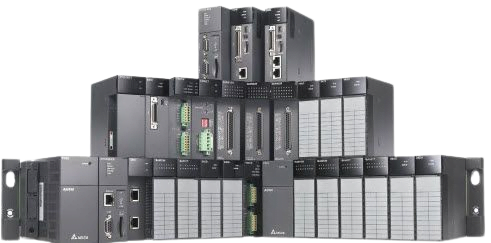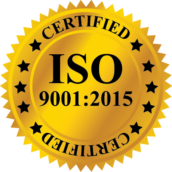An Overview of Programmable Logic Controllers (PLC)
PROGRAMMABLE LOGIC CONTROLLER (PLC) is an industrial computer control system that continuously monitors the status of input devices and makes decisions based on a specific program to control the status of output devices. Almost any area, machine performance or process can be significantly improved with this type of control system. But the biggest benefit of using a PLC is the ability to modify and simulate a process or processes while collecting and reporting important data. Another advantage of PLC systems is that they are modular. This means you can mix and match input and output device types to best suit your application.
PLC is also used to exchange information between industrial equipment or from a facility to a central location, usually via a PC. PLC is often used to monitor and report equipment, diagnose malfunctions in hardware such as machinery and equipment, and perform event processing.

COMPONENTS OF PLC
A typical PLC is connected to a power supply and consists of a central processing unit (CPU), a mounting rack, read-only memory (ROM), random access memory (RAM), input/output (I/O) modules, a power supply, and a programming device.
The power supply unit converts alternating current (AC) to direct current (DC). Most of the PLC works in direct current but some of them operates in alternating current also.
- Rack
A PLC rack is a chassis with which other components are connected. The connected components in a PLC rack are grouped into three sections: the CPU, multiple I/O modules, and the power source.
- CPU
The central processing unit (CPU) plays crucial role in the plc system. A CPU has two operating modes: programming mode and execution mode. In program initialization mode, the CPU extracts logic from program initialization instructions created by the user on the computer. In run mode, the CPU executes the logic. The CPU controls all PLC operations according to program initialization instructions stored in memory.
A PLC receives data from input devices by the help of I/O modules. The concept of sensing data refers to the nature of PLC input data which comes in the form of electronic signals.
Digital input module handles discrete signals, for example on/off signals. Analog input module convert voltage into numbers the CPU can understand.
Digital output module turns devices on and off, for example a light. Analog output modules convert digital numbers to voltage, for example to drive machinery.
PLCs can make logical decisions and perform actions based on the input data they receive, for example processing input data and sending processed data to an output device. The processing of input data is executed by a programming device.
ROM stores information about the operating system and drivers. RAM stores the state and details of input and output data and program information.
WORKING OF PLC
There are four main steps in any PLC process; Scan input, scan software, print output and homework. These steps are repeated every time.
Four Steps In The PLC Operations
1.) Input Scan
•Detects the state of all input devices that are connected to the PLC
2.) Program Scan
•Executes the user created program logic
3.) Output Scan
•Energizes or de-energize all output devices that are connected to the PLC.
4.) logic scan
•This step includes communications with programming terminals, internal diagnostics, etc…
HOW IS A PLC PROGRAMMED?
PLC programming uses a ladder logic programming language, but other languages such as block diagram, structured text, sequential function chart, and instruction list are also used. Logic uses a schematic diagram based on a circuit diagram to represent and express the logic of operations in a PLC software program. Logical level code is similar to an electrical diagram.
ADVANTAGES OF PLC
- Reliability: PLC is designed to be rugged and reliable, making it suitable for industrial applications. The probability of failure is less than other control systems. PLC can be programmed to perform multiple functions, increasing reliability.
- Flexibility: PLC can be easily customized according to needs and requirements. It is flexible and can perform different functions according to the logic of the program.
- Ease of Use: PLCs are especially easy to use compared to other industrial control systems. They use a proprietary programming language and most have a user-friendly interface for easy programming and troubleshooting.
- Cost-Effectiveness: PLC is generally more cost effective than other control systems. PLCs offer an economical solution in the field of installation, maintenance and repair. LCs are generally more cost-effective than other control systems.
- Security features:
The PLC may include safety features to protect personnel and equipment. For example, they can stop the process in special cases (e.g. machine overheating or an accident). - Scalability
The PLC can be scaled up or down depending on the complexity of the control system. Whether the program is simple or complex, PLC can handle it. - Improve response time:
PLC provides timely control by responding quickly to input signals. This fast response time is important for critical applications. - durability:
PLC is built to withstand harsh industrial environments such as extreme temperatures, humidity and vibration. - Data collection and processing:
PLC can collect data from sensors and devices, which helps with monitoring and efficiency. They process this information carefully to make informed decisions. - Remote access:
PLC enables remote monitoring and adjustment necessary for maintenance and troubleshooting.
click here to know about servo drive
- Image
- SKU
- Rating
- Price
- Stock
- Availability
- Add to cart
- Description
- Content
- Weight
- Dimensions
- Additional information








One thought on “An Overview of Programmable Logic Controllers (PLC)”
Your writing has a way of resonating with me on a deep level. I appreciate the honesty and authenticity you bring to every post. Thank you for sharing your journey with us.